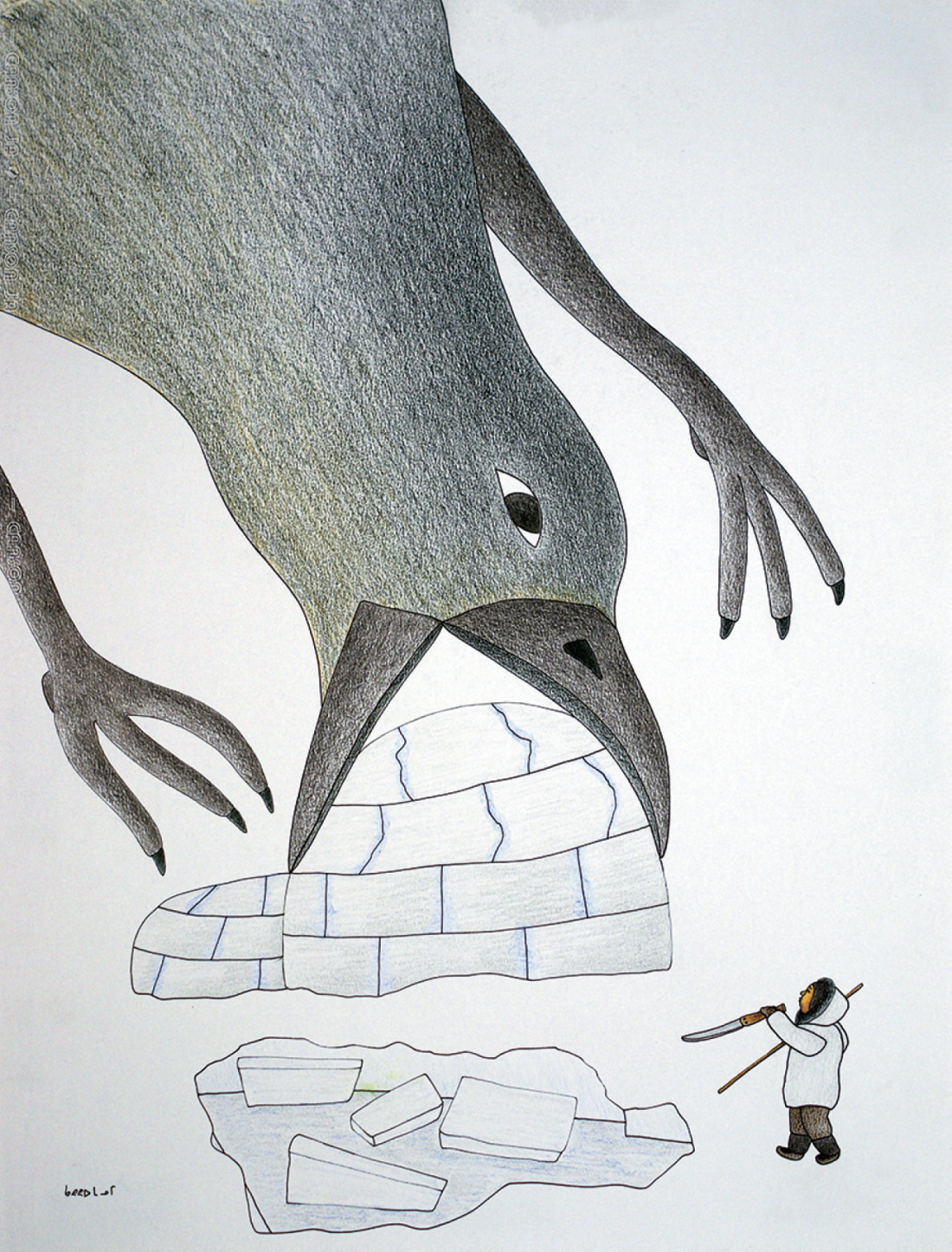Qavavau Manumie
The title for Qavavau Manumie’s show at Marion Scott Gallery, “Cold Dream,” is an apt metaphor for this collection of recent drawings by the Cape Dorset artist. Comprised of 25 works on paper spanning the last eight years, the exhibition presents a range of Manumie’s styles, showcasing his surreal sensibilities and representations of wildlife, landscapes and people. Using motifs drawn from traditional Inuit culture, Manumie transforms these themes into dreamlike images of originality and complexity, reflecting a unique and contemporary vision.
Like other Inuit artists of his generation, and before, Manumie’s work explores the impact of contact with settlers and the after-effects of colonization upon Nunavut. In this exhibition, Manumie joins the tradition of other Cape Dorset artists, working in a variety of mediums, who have presented similar observations through their art. He presents pictures of planes and Ski-Doos, a catalogue of evidence of how the Northern landscape has been changed forever by this contact with “civilization.” In untitled (ski-doo repairs), 2001, Manumie humorously presents us with the broken pieces of a snow machine, next to a Ski-Doo sheltered under a tarp. The image not only elicits a sense of mechanical failure but of capture too, as if we are witness to a breakdown of possibly more mythic proportions. As in many of his works, Manumie’s humour challenges our perception of reality, presenting multiple interpretations.

Qavavau Manumie, untitled (raven crushing igloo), 2011, coloured pencil, graphite and ink on paper. Photograph: Charles Bateman. Courtesy Marion Scott Gallery | Kardosh Projects.
Through a clever series of perspectives, the artist displaces the viewer, looking from multiple points of view—from a bird’s eye to seeing through a sheet of ice. The spare and elegant simplicity of his drawings only belies their complication of varying perspectives, compounded by a skilful arrangement in composition and in knowing where to draw the observer’s eye, both tricking and teaching us where to look. Complicit in this is Manumie’s skill in using whiteness—as snow, as page, as symbol—for a backdrop to exploring larger questions of nature and culture, while simultaneously challenging our perception and understanding of these conceptual frameworks. Birds are present in all of his pictures, calling up questions of flight, or acting as spirit guides.
Manumie’s occupation as a printmaker is evident in all of these works: the concise precision of his lines; the acute attention to detail. His palette, too, shows evidence of his printmaker’s vocation—icy blue and green pool within the exact execution of black lines, save for one picture done in hot shocks of pink and orange. Motifs, too, repeat endlessly: hallucinogenic, kaleidoscopic, in dizzying circular formation.
While animals of all shapes and sizes dominate the landscape, many humans are depicted as one-dimensional stick figures. In a work like untitled (little people in a maze), 2009, Manumie presents a kind of subdued Where’s Waldomeets- MC-Escher mash-up, suggesting that there’s something flat and cartoony about us, lost in our riveted labyrinth with no hope of escape. Only through our connection to the land, to plants and animals, do we have the opportunity to define ourselves as human. This is especially true in untitled (Vancouver Aquarium), 2009, represented by the childlike shadowy figure that appears to hold the flipper of the minty beluga beckoning from beyond the glass, surrounded by a cloud of fish and jellyfish, sea stars, crustaceans and amoebas. This picture is made all the more meaningful by the fact that we too, like the figure in the drawing, are looking into the picture, but through the container of the gallery, through art.

Qavavau Manumie, untitled (little people in a maze), 2009, coloured pencil, graphite and ink on paper. Photograph: Charles Bateman. Courtesy Marion Scott Gallery | Kardosh Projects.
The art of story through the power of traditional Inuit myths and legends has important significance in all of these works. untitled (raven crushing igloo), 2011, is the most suggestive of this, depicting a giant raven capsizing an igloo with its beak, the small human figure to the side, helplessly watching. What can one do? Narrative events can have the power to consume and destroy us, but they can also bring new light to our lives. Manumie’s works convey and confirm how important these traditional stories are, and how they must continue to be heard and told in all forms.
While there is no mention of climate change or the impact of global warming upon Canada’s High North in this exhibition, the title of the show still suggests the desire or will to embody the idea of cold through dreaming, to return to a state of sleeping that permits this ideological state. It is this sense of the sleeper—dreaming and weaving time, place, narrative, and event—touching on what is beneath the surface of things that the work evokes while it challenges our perspective in approaching what is hidden, or perhaps just in plain sight before our eyes. ❚
“Cold Dream: Drawings by Qavavau Manumie” was exhibited at Marion Scott Gallery, Vancouver, from December 5, 2015 to January 9, 2016.
Christine Walde is a poet and librarian in Victoria, BC.

